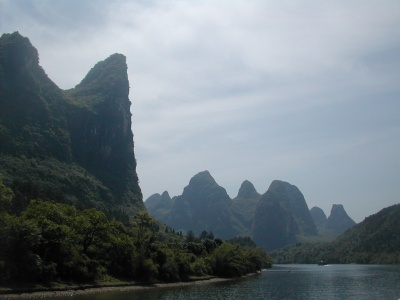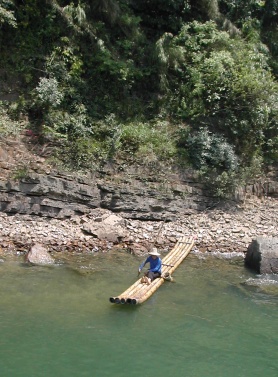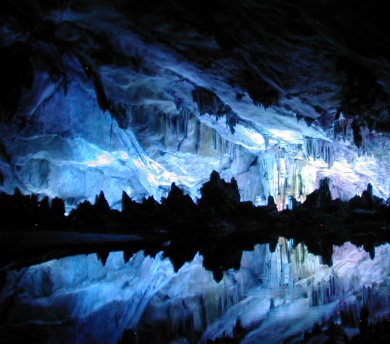GUILIN
Guilin, a relatively small city of only 600,000, became the capital of the Guangxi province during the Ming dynasty; however, the capital was moved to Nanning in 1914. Nonetheless, Guilin continues to draw many visitors to see its karst peaks.
Karst is weathered limestone. The limestone was created from fossilized prehistoric sea floor sediments which were brought to the surface by geological upheavals. Once exposed, the alkaline limestone was eroded by acidic rain, and the above-ground result has been magnificent peaks and pinnacles. Underground, the limestone erosion has created dramatic caves. We were able to see this karst both above ground and within a spectacular cave.
Surface karst is either fenglin karst or fengcong karst. Fenglin karst is steep and vertical. Fengcong karst is more rounded, and it may form small rolling clusters. We saw both.
We arrived at Guilin on a late night flight from Chongqing, and we got only a few hours’ sleep. In the morning, we boarded a boat for a leisurely day trip south on the Li River to Yangshuo.

Karst along Li River
The Li River is a shallow, and sometimes steep-sided, river that meanders through rural villages and bamboo forests with karst formations all around. It takes approximately six hours to go from Guilin to Yangshuo on the river, and the karst formations become more plentiful and dramatic as one travels further south toward Yangshuo.
The local population travels the river on bamboo rafts which are simply five or six large bamboo trunks lashed together. These rafts also became more plentiful as we neared Yangshuo.
We disembarked in Yangshuo, and we had a very good – albeit too brief – stay there. Then we returned to Guilin by road. As we traveled the 44 miles north, we stopped at the Reed Flute Caves and the South China Sea Pearl Exhibition Center.

Local travel on the Li River
The Reed Flute Caves, known locally as Ludi Yan, are formed by karst stalagmites and stalactites and water that continue to transform the limestone. Huge caverns have formed as well as spacious winding tunnels that average 33 feet in height. These tunnels wind for 1,640 feet through Guangming Hill. They have come to be known as Reed Flute Caves because of the sound heard in one area of the caves – obviously it sounds like a reed flute.
These caves are only three miles away from Guilin’s city center, and they were often used as a place to hide during the Japanese invasion during the 1940s. Because residents often entered these caves hurriedly, many stalagmites were removed to prevent stumbling and falling. Many of these stalagmites have been relocated along the tunnel walkway making it easy to find one’s way through the caves.
Light is needed to see inside the caves, and many areas of the interior of the caves are lit with colored lights. Although this is colorful, and it adds to the visual impact, we thought that it detracted from the stark natural beauty of the caves. The caves do not need to be enhanced to awe visitors.

Lit cave wall reflecting on fresh water poolL
Uh oh – this is another state-run outlet. We were a bit cynical before we even went in, but we did go in, and our cynicism was warranted.
We were given a brief introduction to the process of pearl formation which we already knew well. Then we watched a mercifully brief computer generated presentation. Then – the piece de resistance – the fashion show. We listened to dreadful music as we watched a few local women sashay down the plywood runway wearing too much make-up and gaudy jewelry. The best we can say about it is that it was brief.
We were told that we would get a 20% discount on any purchase for coming as part of a group. Although we had not planned on buying anything, Nita did see a pair of pink pearl earrings that she liked. When we decided to buy them, the discount shrunk to 10%. Our urge to buy also shrunk, and we did not buy them.
Our hotel in Guilin that night looked very welcoming for these two weary travelers. We were wearing down, and we still had not seen the bright lights and big city of Shanghai. We flew from Guilin to Shanghai.
Follow us to Yangshuo or Shanghai or return to our China page.